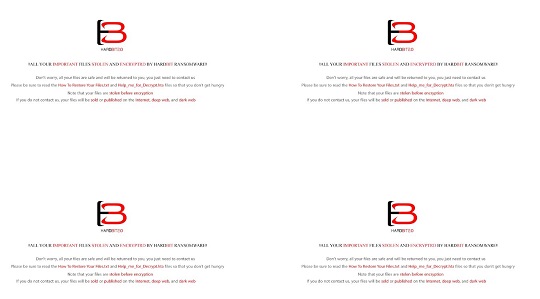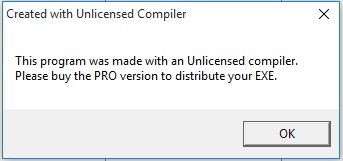Ransom.MSIL.HARDBIT.THAODBC
UDS:Trojan.MSIL.DelShad.gen (KASPERSKY) ; Ransom:Win32/Hardbit!MTB (MICROSOFT)
Windows

Tipo de grayware:
Ransomware
Destrutivo:
Não
Criptografado:

In the Wild:
Sim
Visão geral
It arrives on a system as a file dropped by other malware or as a file downloaded unknowingly by users when visiting malicious sites.
Detalhes técnicos
Übertragungsdetails
It arrives on a system as a file dropped by other malware or as a file downloaded unknowingly by users when visiting malicious sites.
Installation
Schleust die folgenden Dateien ein:
- %User Profile%\DOCUMENTS\hrdb.ico → icon used for all encrypted files
- %Desktop%\HARDBIT.jpg → image used as system wallpaper after encryption
- %User Temp%\lsm.exe → detected as TROJ_GEN.R002H09HJ23
- %User Temp%\is64.txt → identifies the OS architecture
- %User Temp%\is64.bat
- %User Temp%\is64.fil → contains the path to the 64-bit cmd.exe
(Hinweis: %User Profile% ist der Ordner für Benutzerprofile des aktuellen Benutzers, normalerweise C:\Windows\Profile\{Benutzername} unter Windows 98 und ME, C:\WINNT\Profile\{Benutzername} unter Windows NT, C:\Dokumente und Einstellungen\{Benutzername} unter Windows 2000(32-bit), XP und Server 2003(32-bit) und C:\Users\{user name} unter Windows Vista, 7, 8, 8.1, 2008(64-bit), 2012(64-bit) und 10(64-bit).. %Desktop% ist der Ordner 'Desktop' für den aktuellen Benutzer, normalerweise C:\Windows\Profile\{Benutzername}\Desktop unter Windows 98 und ME, C:\WINNT\Profile\{Benutzername}\Desktop unter Windows NT, C:\Dokumente und Einstellungen\{Benutzername}\Desktop unter Windows 2000(32-bit), XP und Server 2003(32-bit) und C:\Users\{Benutzername}\Desktop unter Windows Vista, 7, 8, 8.1, 2008(64-bit), 2012(64-bit) und 10(64-bit).. %User Temp% ist der Ordner 'Temp' des aktuellen Benutzers, normalerweise C:\Dokumente und Einstellungen\{Benutzername}\Lokale Einstellungen\Temp unter Windows 2000(32-bit), XP und Server 2003(32-bit) und C:\Users\{Benutzername}\AppData\Local\Temp unter Windows Vista, 7, 8, 8.1, 2008(64-bit), 2012(64-bit) und 10(64-bit).)
Fügt die folgenden Prozesse hinzu:
- cmd.exe /C sc delete VSS
- cmd.exe /C wbadmin delete catalog -quiet
- cmd.exe /C vssadmin delete shadows /all /quiet & wmic shadowcopy deletee
- cmd.exe /C bcdedit /set {default} bootstatuspolicy ignoreallfailures & bcdedit /set {default} recoveryenabled no
- "powershell" Get-MpPreference -verbose
- net.exe stop avpsus /y
- net.exe stop McAfeeDLPAgentService /y
- net.exe stop mfewc /y
- net.exe stop BMR Boot Service /y
- net.exe stop NetBackup BMR MTFTP Service /y
- net.exe stop DefWatch /y
- net.exe stop ccEvtMgr /y
- net.exe stop ccSetMgr /y
- net.exe stop SavRoam /y
- net.exe stop RTVscan /y
- net.exe stop QBFCService /y
- net.exe stop QBIDPService /y
- net.exe stop IntuitQuickBooksFCS /y
- net.exe stop QBCFMonitorService /y
- net.exe stop YooBackup /y
- net.exe stop YooIT /y
- net.exe stop zhudongfangyu /y
- net.exe stop stc_raw_agent /y
- net.exe stop VSNAPVSS /y
- net.exe stop VeeamTransportSvc /y
- net.exe stop VeeamDeploymentService /y
- net.exe stop VeeamNFSSvc /y
- net.exe stop veeam /y
- net.exe stop PDVFSService /y
- net.exe stop BackupExecVSSProvider /y
- net.exe stop BackupExecAgentAccelerator /y
- net.exe stop BackupExecAgentBrowser /y
- net.exe stop BackupExecDiveciMediaService /y
- net.exe stop BackupExecJobEngine /y
- net.exe stop BackupExecManagementService /y
- net.exe stop BackupExecRPCService /y
- net.exe stop AcrSch2Svc /y
- net.exe stop AcronisAgent /y
- net.exe stop CASAD2DWebSvc /y
- net.exe stop CAARCUpdateSvc /y
- net.exe stop sophos /y
- net.exe stop -n apache24
- net.exe stop mysql57
- net.exe wrapper
- net.exe DefWatch
- net.exe stop SavRoam /y
- net.exe stop Sqlservr /y
- net.exe stop sqlagent /y
- net.exe stop sqladhlp /y
- net.exe stop Culserver /y
- net.exe stop sqlbrowser /y
- net.exe stop QLADHLP /y
- net.exe stop Intuit /y
- net.exe stop QuickBooks /y
- net.exe stop FCS /y
- net.exe stop msmdsrv /y
- net.exe stop tomcat6 /y
- net.exe stop vmware /y
- net.exe stop vmware-converter /y
- net.exe stop dbsrv12 /y
- net.exe stop dbeng8 /y
- net.exe stop MSSQL$MICROSOFT /y
- net.exe stop ##WID /y
- net.exe stop MSSQL$VEEAMSQL2012 /y
- net.exe stop SQLAgent$VEEAMSQL2012 /y
- net.exe stop SQLBrowser /y
- net.exe stop SQLWriter /y
- net.exe stop FishbowlMySQL /y
- net.exe stop MySQL57 /y
- net.exe stop MSSQL$KAV_CS_ADMIN_KIT /y
- net.exe stop MSSQLServerADHelper100 /y!
- net.exe stop SQLAgent$KAV_CS_ADMIN_KIT /y
- net.exe stop msftesql /y
- net.exe stop Exchange /y
- net.exe stop MSSQL$MICROSOFT##SSEE /y
- net.exe stop MSSQL$SBSMONITORING /y
- net.exe stop MSSQL$SHAREPOINT /y
- net.exe stop MSSQLFDLauncher$SBSMONITORING /y
- net.exe stop SQLAgent$SBSMONITORING /y
- net.exe stop SQLAgent$SHAREPOINT /y
- net.exe stop QBVSS /y
- net.exe stop vss /y
- net.exe stop sql /y
- net.exe stop svc$ /y
- net.exe stop MSSQL /y
- net.exe stop MSSQL$ /y
- net.exe stop memtas /y
- net.exe stop mepocs /y
- net.exe stop backup /y
- net.exe stop bedbg /y
- net.exe stop MVArmor /y
- net.exe stop MVarmor64 /y
- net.exe stop ARSM /y
- net.exe stop WSBExchange /y
- net.exe stop MSExchange /y
- net.exe stop MSExchange$ /y
- %User Temp%\lsm.exe
- %User Temp%\is64.bat
- "%System%\mshta.exe" "%User Temp%\readme-warning.hta"
(Hinweis: %User Temp% ist der Ordner 'Temp' des aktuellen Benutzers, normalerweise C:\Dokumente und Einstellungen\{Benutzername}\Lokale Einstellungen\Temp unter Windows 2000(32-bit), XP und Server 2003(32-bit) und C:\Users\{Benutzername}\AppData\Local\Temp unter Windows Vista, 7, 8, 8.1, 2008(64-bit), 2012(64-bit) und 10(64-bit).. %System% ist der Windows Systemordner. Er lautet in der Regel C:\Windows\System unter Windows 98 und ME, C:\WINNT\System32 unter Windows NT und 2000 sowie C:\Windows\System32 unter Windows 2000(32-bit), XP, Server 2003(32-bit), Vista, 7, 8, 8.1, 2008(64-bit), 2012(64bit) and 10(64-bit).)
Erstellt die folgenden Ordner:
- %User Temp%\myfiles
- %User Temp%\wxy
(Hinweis: %User Temp% ist der Ordner 'Temp' des aktuellen Benutzers, normalerweise C:\Dokumente und Einstellungen\{Benutzername}\Lokale Einstellungen\Temp unter Windows 2000(32-bit), XP und Server 2003(32-bit) und C:\Users\{Benutzername}\AppData\Local\Temp unter Windows Vista, 7, 8, 8.1, 2008(64-bit), 2012(64-bit) und 10(64-bit).)
Andere Systemänderungen
Fügt die folgenden Registrierungseinträge hinzu:
HKEY_USERS\{SID}_CLASSES\.hardbit2\
DefaultIcon
(Default) = %User Profile%\Documents\hrdb.ico
Fügt die folgenden Registrierungsschlüssel als Teil der Installationsroutine hinzu:
HKEY_USERS\{SID}_CLASSES\.hardbit2
HKEY_USERS\{SID}_CLASSES\.hardbit2\
DefaultIcon
Ändert die folgenden Registrierungseinträge:
HKEY_LOCAL_MACHINE\SOFTWARE\Policies\
Microsoft\Windows Defender
DisableAntiSpyware = 1
(Note: The default value data of the said registry entry is 0.)
HKEY_LOCAL_MACHINE\SOFTWARE\Policies\
Microsoft\Windows Defender\Real-Time Protection
DisableBehaviorMonitoring = 1
(Note: The default value data of the said registry entry is 0.)
HKEY_LOCAL_MACHINE\SOFTWARE\Policies\
Microsoft\Windows Defender\Real-Time Protection
DisableOnAccessProtection = 1
(Note: The default value data of the said registry entry is 0.)
HKEY_LOCAL_MACHINE\SOFTWARE\Policies\
Microsoft\Windows Defender\Real-Time Protection
DisableScanOnRealtimeEnable = 1
(Note: The default value data of the said registry entry is 0.)
Ändert das Hintergrundbild des Desktops durch Abänderung der folgenden Registrierungseinträge:
HKEY_CURRENT_USER\Control Panel\Desktop
Wallpaper = %Desktop%\HARDBIT.jpg
Stellt auf dem System das folgende Bild als Desktop-Hintergrundbild ein:
- %Desktop%\HARDBIT.jpg

Prozessbeendigung
Beendet die folgenden Dienste, wenn sie auf dem betroffenen System gefunden werden:
- avpsus
- McAfeeDLPAgentService
- mfewc
- BMR Boot Service
- NetBackup BMR MTFTP Service
- DefWatch
- ccEvtMgr
- ccSetMgr
- SavRoam
- RTVscan
- QBFCService
- QBIDPService
- IntuitQuickBooksFCS
- QBCFMonitorService
- YooBackup
- YooIT
- zhudongfangyu
- stc_raw_agent
- VSNAPVSS
- VeeamTransportSvc
- VeeamDeploymentService
- VeeamNFSSvc
- veeam
- PDVFSService
- BackupExecVSSProvider
- BackupExecAgentAccelerator
- BackupExecAgentBrowser
- BackupExecDiveciMediaService
- BackupExecJobEngine
- BackupExecManagementService
- BackupExecRPCService
- AcrSch2Svc
- AcronisAgent
- CASAD2DWebSvc
- CAARCUpdateSvc
- sophos
- apache24
- mysql57
- SavRoam
- Sqlservr
- sqlagent
- sqladhlp
- Culserver
- sqlbrowser
- QLADHLP
- Intuit
- QuickBooks
- FCS
- msmdsrv
- tomcat6
- vmware
- vmware-converter
- dbsrv12
- dbeng8
- MSSQL$MICROSOFT
- ##WID
- MSSQL$VEEAMSQL2012
- SQLAgent$VEEAMSQL2012
- SQLBrowser
- SQLWriter
- FishbowlMySQL
- MySQL57
- MSSQL$KAV_CS_ADMIN_KIT
- MSSQLServerADHelper100!
- SQLAgent$KAV_CS_ADMIN_KIT
- msftesql
- Exchange
- MSSQL$MICROSOFT##SSEE
- MSSQL$SBSMONITORING
- MSSQL$SHAREPOINT
- MSSQLFDLauncher$SBSMONITORING
- SQLAgent$SBSMONITORING
- SQLAgent$SHAREPOINT
- QBVSS
- vss
- sql
- svc$
- MSSQL
- MSSQL$
- memtas
- mepocs
- backup
- bedbg
- MVArmor
- MVarmor64
- ARSM
- WSBExchange
- MSExchange
- MSExchange$
Beendet Prozesse oder Dienste, die einen oder mehrere dieser Zeichenfolgen enthalten, wenn sie im Speicher des betroffenen Systems ausgeführt werden:
- 360Doctor
- 360Se
- acwebbrowser
- ADExplorer
- ADExplorer64
- ADExplorer64a
- Adobe
- AdobeCollabSync
- AdobeIPCBroker
- agntsvc
- AutodeskDesktopApp
- Autoruns
- Autoruns64
- Autoruns64a
- Autorunsc
- Autorunsc64
- Autorunsc64a
- avz
- axlbridge
- bedbh
- benetns
- bengien
- beserver
- BrCcUxSys
- BrCtrlCntr
- CagService
- calc
- CEF
- Cloud
- CoreSync
- Creative
- Culture
- dbeng50
- dbsnmp
- Defwatch
- DellSystemDetect
- dumpcap
- encsvc
- EnterpriseClient
- excel
- fbguard
- fbserver
- fdhost
- fdlauncher
- firefox
- GDscan
- GlassWire
- GWCtlSrv
- Helper
- httpd
- infopath
- InputPersonalization
- isqlplussvc
- j0gnjko1
- java
- koaly-exp-engine-service
- msaccess
- mspub
- mydesktopqos
- mydesktopservice
- mysqld
- node
- notepad
- notepad++
- ocautoupds
- ocomm
- ocssd
- onedrive
- onenote
- ONENOTEM
- oracle
- outlook
- powerpnt
- ProcessHacker
- Procexp
- Procexp64
- procexp64a
- procmon
- procmon64
- procmon64a
- pvlsvr
- QBDBMgr
- QBDBMgrN
- QBIDPService
- qbupdate
- QBW32
- Raccine
- Raccine_x86
- RaccineElevatedCfg
- RaccineSettings
- RAgui
- raw_agent_svc
- RdrCEF
- RTVscan
- sam
- Service
- SimplyConnectionManager
- SimplySystemTrayIcon
- sqbcoreservice
- sqlbrowser
- sqlmangr
- Sqlservr
- Ssms
- steam
- supervise
- sync
- synctime
- Sysmon
- Sysmon64
- SystemExplorer
- SystemExplorerService
- SystemExplorerService64
- taskbar
- tbirdconfig
- tcpview
- tcpview64
- tcpview64a
- tdsskiller
- TeamViewer
- TeamViewer_Service
- thebat
- thunderbird
- TitanV
- tomcat6
- Totalcmd
- Totalcmd64
- tv_w32
- tv_x64
- VeeamDeploymentSvc
- visio
- vsnapvss
- vss
- vxmon
- wdswfsafe
- winword
- WireShark
- wordpad
- worker
- wsa_service
- wuauclt
- wxServer
- wxServerView
- xfssvccon
- ZhuDongFangYu
Datendiebstahl
Folgende Daten werden gesammelt:
- Hardware information (CPU, Disk Drives, Graphics Card, Manufacturer, BIOS)
- Network adapter settings (IP configuration, MAC address)
- Username
- Computer Name
- Timezone Information
Andere Details
Es macht Folgendes:
- It changes the encrypted file icon to the following image:

- %User Temp%\lsm.exe shows the following message box:

Solução
Step 2
Für Windows ME und XP Benutzer: Stellen Sie vor einer Suche sicher, dass die Systemwiederherstellung deaktiviert ist, damit der gesamte Computer durchsucht werden kann.
Step 3
<p> Beachten Sie, dass nicht alle Dateien, Ordner, Registrierungsschlüssel und Einträge auf Ihrem Computer installiert sind, während diese Malware / Spyware / Grayware ausgeführt wird. Dies kann auf eine unvollständige Installation oder andere Betriebssystembedingungen zurückzuführen sein. Fahren Sie mit dem nächsten Schritt fort. </ p><p> Beachten Sie, dass nicht alle Dateien, Ordner, Registrierungsschlüssel und Einträge auf Ihrem Computer installiert sind, während diese Malware / Spyware / Grayware ausgeführt wird. Dies kann auf eine unvollständige Installation oder andere Betriebssystembedingungen zurückzuführen sein. Fahren Sie mit dem nächsten Schritt fort. </ p>
Step 4
Diesen geänderten Registrierungswert wiederherstellen
Wichtig: Eine nicht ordnungsgemäße Bearbeitung der Windows Registrierung kann zu einer dauerhaften Fehlfunktion des Systems führen. Führen Sie diesen Schritt nur durch, wenn Sie mit der Vorgehensweise vertraut sind oder wenn Sie Ihren Systemadministrator um Unterstützung bitten können. Lesen Sie ansonsten zuerst diesen Microsoft Artikel, bevor Sie die Registrierung Ihres Computers ändern.
- HKEY_LOCAL_MACHINE\SOFTWARE\Policies\Microsoft\Windows Defender
- DisableAntiSpyware=1
- DisableAntiSpyware=0
- HKEY_LOCAL_MACHINE\SOFTWARE\Policies\Microsoft\Windows Defender\Real-Time Protection
- DisableBehaviorMonitoring=1
- DisableBehaviorMonitoring= 0
- HKEY_LOCAL_MACHINE\SOFTWARE\Policies\Microsoft\Windows Defender\Real-Time Protection
- DisableOnAccessProtection=1
- DisableOnAccessProtection= 0
- HKEY_LOCAL_MACHINE\SOFTWARE\Policies\Microsoft\Windows Defender\Real-Time Protection
- DisableScanOnRealtimeEnable=1
- DisableScanOnRealtimeEnable= 0
Step 5
Delete this registry key
=Important: Editing the Windows Registry incorrectly can lead to irreversible system malfunction. Please do this only if you know how to or you can seek your system administrator’s help. You may also check out this Microsoft article first before modifying your computer's registry.
- In HKEY_USERS\{SID}_CLASSES\.hardbit2
Step 6
Diese Datei suchen und löschen
- {Encrypted Directory}\How To Restore Your Files.txt
- {Encrypted Directory}\Help_me_for_Decrypt.hta
- %User Temp%\readme-warning.hta
- %User Profile%\DOCUMENTS\hrdb.ico
- %User Temp%\lsm.exe
- %User Temp%\is64.txt
- %User Temp%\is64.bat
- %User Temp%\is64.fil
- %Desktop%\HARDBIT.jpg
Step 7
Diese Ordner suchen und löschen
- %User Temp%\myfiles
- %User Temp%\wxy
Step 8
Durchsuchen Sie Ihren Computer mit Ihrem Trend Micro Produkt, und löschen Sie Dateien, die als Ransom.MSIL.HARDBIT.THAODBC entdeckt werden. Falls die entdeckten Dateien bereits von Ihrem Trend Micro Produkt gesäubert, gelöscht oder in Quarantäne verschoben wurden, sind keine weiteren Schritte erforderlich. Dateien in Quarantäne können einfach gelöscht werden. Auf dieser Knowledge-Base-Seite finden Sie weitere Informationen.
Step 9
Desktop-Eigenschaften zurücksetzen
Step 10
Restore encrypted files from backup.
Participe da nossa pesquisa!

